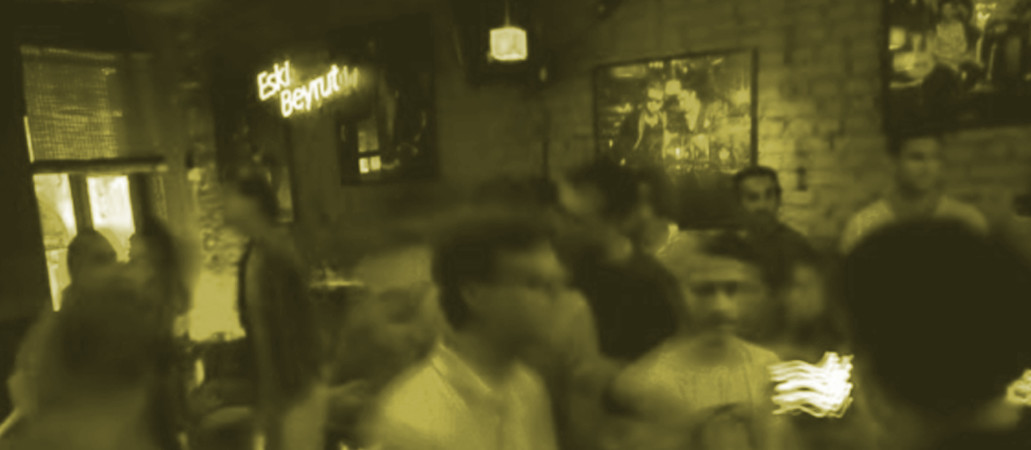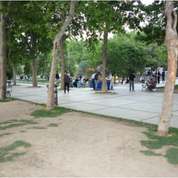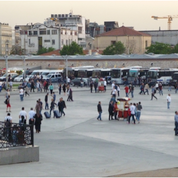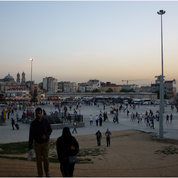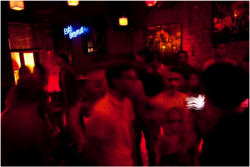The idea of a research on the Erasmus programme and its manifestations in Istanbul was to ask why students from all over Europe chose Istanbul as their destination and how they are living in the global city. The project of Anna Schäfer and Laura Lamping highlights different perspectives of doing Erasmus in Istanbul: from the bureaucratic burdens of universities, to student’s romanticism of living in “the exotic East” and their ways of living between Erasmus Parties and protest movements.
The Erasmus Programme existing since 1987 constitutes one of the most popular exchange programmes supported by the European Union. Since its creation, over two million students have participated in the Erasmus Programme and went abroad. So far, around 3.000 institutions from 33 European countries have taken part in the programme 1. On the one hand, the programme provides students with better opportunities for going abroad, but on the other hand, universities are confronted with manifold administrative hurdles as they have to coordinate with universities from other countries. Nevertheless, many students enjoy the collective or unique experience including the cultural exchange with other Erasmus participants. 2
Therefore, not only universities follow the ongoing process of internationalization 3. Students have since realized the potential of and the need for international experiences for successful careers – and they value the possibility of having fun and spending a good time with other young people from places all over the world. Turkey especially has become very attractive for a short-time stay of six to twelve months. In 2012, around 6.000 students took the chance to visit Turkey through Erasmus 4. Also, Istanbul seems to become increasingly attractive to students: “Every year, we get more and more Erasmus incoming students […]” said M., an Erasmus coordinator of an Istanbul university 5.
Is The Erasmus Programme Contributing to the Global City Image?
The Erasmus Programme can be analyzed with regard to image benefits not only for the universities but also for the city (government). The increasing number of Erasmus students in Turkey is certainly linked to the universities’ aspirations to international reputation. Different strategies and instruments of city policies such as support programmes, monument protection laws and housing legislation have already been analyzed in urban studies with regard to gentrification processes 6. Our research posed the question if the specific support programme Erasmus might be connected to the city government’s attempts at creating Western, cosmopolitan, international and democratic flair. Erasmus could then be situated within the wider context of neo-liberalism and the global city concept.
Fußnoten:
- 1 Cf. Wuttig, Siegbert: “Vorwort“, in: DAAD Euroletter. Informationen zur EU-Bildungs- und Hochschulzusammenarbeit, August 2012, https://eu.daad.de/medien/eu/publikationen/sonderausgabe_euroletter.pdf (last accessed July 2015). ↩
- 2 Cf. Tekin, Uğur: “Auswirkungen des ERASMUS-Programms auf Universitäten und Studierende in der Türkei“, in: Pusch, Barbara (ed.): Transnationale Migration am Beispiel Deutschland und Türkei, Wiesbaden: Springer 2013, pp. 279-290, here p. 279. ↩
- 3 Cf. Tekin, Uğur: “Auswirkungen des ERASMUS-Programms auf Universitäten und Studierende in der Türkei“, in: Pusch, Barbara (ed.): Transnationale Migration am Beispiel Deutschland und Türkei, Wiesbaden: Springer 2013, pp. 279-290, here p. 280. ↩
- 4 Cf. Acker, Samuel: “Die Brücke nach Europa wackelt“, in: Zeit Online, March 18, 2014, http://www.zeit.de/studium/hochschule/2014-03/eu-tuerkei-erasmus (last accessed July 2015). ↩
- 5 Interview with M., an Erasmus coordinator of an Istanbul university (May 30, 2014). ↩
- 6 Cf. Holm, Andrej: “Gentrification”, in: Eckardt, Frank (ed.): Handbuch Stadtsoziologie, Wiesbaden: Springer 2012, pp. 661-679, here p. 670. Holm names Loretta Lees as an example for this kind of approach in urban research. ↩
Every incoming student surely has their own motivation for spending their Erasmus year in Istanbul. The reasons may merely be bureaucratic ones: As M., a student from Berlin, told us, not Istanbul, but rather Barcelona had been her first choice – but finally she was very happy that the Erasmus system ‘made’ her go to Istanbul:
“Turkey, that was rather coincidence. Actually, I wanted to go to Spain, but all in all that didn’t work out. And then I went to Istanbul, […] what I found even cooler. Well, yes, Spain had lost its attraction for me somehow.” 1
Nevertheless, there might be specific reasons for choosing this global city. Speaking to a Turkish student who organizes parties and other activities was enlightening as he stated the main reason for coming to Istanbul to be the Bosporus 2. It is not only about the Bosporus – rather, it is the image of the city which seems to be so attractive. N., a German Erasmus student staying in Istanbul, confirmed this assumption:
“The image of the city Istanbul as a very beautiful city is being told all the time […] but also for me the reason to come here was that there might be not as much Erasmus students like in other cities.” 3
Thus, Istanbul seems to be somewhat exotic, a city worth seeing. If you go to Istanbul, you are not comparable to other Erasmus students. You have visited a place no one else has seen so far: If you have been here as an exchange student, you experienced something special, you gained so-called “cultural capital” (in terms of Bourdieu). 4 In this case, travelling as a form of gaining cultural capital means that you make investments in order to get to know a country, to learn a language, to experience something special you will be able to talk about once you are back home. The wish to be part of this special, exotic experience might be one reason for incoming (European) students to go to Istanbul – which is possible since Turkey became part of the Erasmus programme in 2004. Ten years have passed – enough time for Istanbul to become popular among Erasmus students.
Cool Istanbul – The Promotion of Istanbul as the Erasmus Place
The idea of Istanbul as a unique place to spend the Erasmus term is supported and spread by Erasmus coordinators of German and Turkish universities participating in the programme. To M., the manager of the Erasmus office at a university in Istanbul,
“Istanbul is unique in the world, it’s like a huge melting pot and it’s one of the cities that never sleeps. […] It’s always activity, it’s always life, there is always something happening. […] You have the beach, you have the mountain if you go a little bit further than Istanbul […]. You have a lot of traffic as well, but when you are young you really don’t feel it. Dynamic city.” 5
S., a student working in a German Erasmus office, advises German students apply for spending their Erasmus year in Istanbul, firstly for practical reasons such as the chance to actually get placed in the programme, and secondly for the internationality of the city, its status as a multicultural metropolis offering numerous possibilities regarding student life. According to him, Istanbul
“is an international city on the same level as Warsaw, Paris, Rome […] where life is very pulsating. On the other hand, I also believe that actually Istanbul has always been such a center of attraction because of its cultural diversity.” 6.
Furthermore, he refers to the history of the city as the capital of the Eastern Roman Empire as attributing to its attractiveness. Thus, again, Istanbul’s geographical location is assigned a cultural meaning and value as a city between East and West, with Asian and European influences.
At this point, it seems appropriate to refer to Edward Said’s concept of Orientalism. As indicated above, stereotypical imaginations of Turkey and especially of Istanbul persist and might influence the students’ decision on where to study abroad.
“Given its alleged position between two counterpoints of cultural history – using phantasms like ‘Orient’ and ‘Occident’ – the Bosporus city appears to be the ideal projection surface for all kinds of stereotyped comments, where one in three sentences contains the word ‘bridge’.” 7
Talking about the “Orient” – from an Erasmus student’s Western perspective – can be quite difficult. On the one hand, you try to overcome the imperialistic point of view connecting the “Orient” to a specific mentality, a holistic character and a very old identity 8. On the other hand, there are still narrow-minded perspectives struggling to accept that a concept of “the Orient” is as disputable as the notion of “the West”. 9 There is a dichotomy in this context: The students we have talked to tried not to give a stereotypical impression of their stay in Istanbul. Nevertheless, we were confronted with typical “exoticist, orientalist” statements.
In this context, however, as outlined above, we have to take into account that the Erasmus field is composed not only of Erasmus students. Rather, it is a complex net of different actors, including the Erasmus coordinators at the universities, tutors and student organizations – they all contribute (presumably rather unconsciously) to the reproduction of specific symbolic attributions and thus partake in the “Orientalist” discourse that is the discursive presentation of the city as “Cool Istanbul”. As M. told us back in Berlin,
“the city is plain folly. […] I haven’t seen such a city before. […] It is absolutely beautiful, well, also because of all the water, but, […] when you once walk from one city district into the next one, you already feel as if your head is about to burst […] because there are so many people everywhere. […] But, it is simply beautiful, and the people are so open and nice.” 10 This Istanbul discourse – on the part of Erasmus students but most importantly on part of the external actors in the Erasmus institutions – might contribute to the growing number of Erasmus students choosing to come to Istanbul.
Fußnoten:
- 1 Interview with M. on May 15, 2014. M. spent one year (2010-2011) as an Erasmus student in Istanbul. In 2012, she went back for several months to do an internship there. The quote is translated from German into English. ↩
- 2 Cf. Interview with U. working for The Best Party Life-organization on May 27, 2014. ↩
- 3 Interview with N., a German Erasmus student who had already lived in Istanbul for a few months at the time we conducted the interview on May 28, 2014 The quote was freely translated from German into English. ↩
- 4 Cf. Bourdieu, Pierre: “Ökonomisches Kapital, kulturelles Kapital, soziales Kapital“, in: Soziale Welt, Sonderband 2 (1983), p. 185. ↩
- 5 Interview with M., an Erasmus coordinator of an Istanbul university on May 30, 2014. ↩
- 6 Interview with S., who works in the Erasmus office of a German university institute on March 16, 2014. The quote was translated from German into English. ↩
- 7 Esen, Orhan: “Learning from Istanbul. The city of Istanbul. Material production and production of the discourse” in: Esen, Orhan/Lanz, Stephan (eds.): Self Service City: Istanbul, Berlin: b_books 2005, p. 1. ↩
- 8 Cf. Kramer, Fritz W.: “Der Kulturbegriff Edward Saids“, in: Schnepel, Burkhard/Brands, Gunnar/Schönig, Hanne (eds.): Orient – Orientalistik – Orientalismus. Geschichte und Aktualität einer Debatte, Bielefeld: transcript 2011, p. 31. ↩
- 9 Cf. Pflitsch, Andreas: Mythos Orient. Eine Entdeckungsreise, Freiburg: Herder Verlag 2003, p. 168. ↩
- 10 Interview with M. on May 15, 2014. The quote was freely translated from German into English. ↩
The EU exchange programme provides students with many services. According to M., an Erasmus coordinator of an Istanbul university, a student receives help with everything from finding an accommodation to getting registered, finding the right courses and getting in touch with other students 1. In conversations with Erasmus students in Istanbul, different behaviors emerged. Some expressed contentment with the services the universities provide. Their enjoyment of partying made it easy for them to get in touch with other Erasmus students. At this point, it is useful to refer to Pierre Bourdieu and his concept of “social capital”. 2 According to Bourdieu, you benefit from your social relationships depending on your membership in certain group: Although you are away from home, you are able to establish a social network without bigger efforts. The interview with N., a German Erasmus student in Istanbul, confirmed this:
“That is the reason why you have these parties. You drink, you are not constrained anymore, you get to know many people and you are not alone.” 3
As Uğur Tekin points out, facilitating contact between Erasmus students is a strength of the programme as students can learn a lot about other cultures through contact with other foreign students 4. Nevertheless, there is also a stereotypical idea of the Erasmus Programme as reproduced on social networks like facebook. This notion focuses on the party scene for foreign students. Here, an adapted infrastructure including clubs offering Erasmus parties or trips only for foreign students comes into play.
On the other side, there are also Erasmus students not wishing be part of this apparently typical “Erasmus -behavior”. Rather, they desire to be part of political movements – in Istanbul especially the Gezi protests – or to be involved in other social projects, for example the migrant solidarity kitchen “Mutfak” in the district Tarlabaşi. This kind of commitment appears to be a way to get to know other parts of the city (the “real” parts) 5, to learn Turkish and to get in touch with “natives”; thus, it is also a way to learn more about other cultures. We talked to a (former) Erasmus student who had participated in protests connected to the Gezi-movement: They reported that there was a group of international students organizing political activism. This can be seen as an intentional distinction from party lifestyle: It is a distinction necessary for forming a(n) (group) identity. You see yourself as different and you want to make this distinction. 6
Nevertheless, it is not possible to distinguish two opposing sides; there are many different ways of being an Erasmus student in Istanbul. This research offers only limited insight into the Erasmus life in Istanbul based on our week-long experience. At the very least, it invites to reconsider the “Erasmus label” sometimes used derogatorily by people not being directly involved with the programme. It shows that image and reality are seldom congruent.
Fußnoten:
- 1 Cf. interview with M., an Erasmus coordinator at a university in Istanbul on May 30, 2014. ↩
- 2 Cf. Bourdieu, Pierre: “Ökonomisches Kapital, kulturelles Kapital, soziales Kapital“, in: Soziale Welt, Sonderband 2 (1983), pp. 190-192. ↩
- 3 Interview with N., a German Erasmus student on May 28, 2014. ↩
- 4 Cf. Tekin, Uğur: “Auswirkungen des Erasmus Programmes auf Universitäten und Studierende in der Türkei“, in: Pusch, Barbara (ed.): Transnationale Migration am Beispiel Deutschland und Türkei, Wiesbaden: Springer 2013, pp. 282-283. ↩
- 5 The quotation marks should illustrate that there are no real or non-real parts. This refers to the concept of Orientalism: You search for the real “exotic” Istanbul. ↩
- 6 Cf. Römhild, Regina: “Ethnizität und Ethnisierung: Die gemanagte Kultur als Ausgrenzungsinstrument“ in: Anerkennung 13 (1998) 2, p. 4. ↩
The Taksim district is located in the center of Istanbul – on the European side. There is almost no place in Istanbul anymore where you have this much space to move. The Taksim Square is a well-known public area playing a significant role in our interviews. Taksim transformed – over the last centuries – to a very complex district. It is a place to live, a place to party and to protest.
- Gezi-Park © Anna Schäfer, Laura Lamping 2014
- Taksim-Square © Anna Schäfer, Laura Lamping 2014
- Taksim-Square © Anna Schäfer, Laura Lamping 2014
Drawing on Erving Goffmann, Taksim Square can be called the place for political action: Here, the players become aware of each other and interact. The players structure the public space and make their behavior apparent to the media. 1 If you have the intention of transporting a message to the public, such a well-known place is an obvious choice. For international students, Taksim Square is fraught with these political overtones. Therefore, they planned for their political protests (in this case, a human chain) to take place in Taksim as long as it was not too dangerous. If they were worried about the police, they would pick another place for their project. 2
There is also another side of this district: the party scene. Many bars and restaurants are located around the Taksim Square. They are known for their international guests. Therefore, Erasmus coordinators, mentors and party organizer advise international students to go there to get in touch with other students. To U. from the student organization The Best Party Life (BPL) and M. from the Erasmus office of one of Istanbul’s universities, Taksim was the indisputable nexus of the party and Erasmus scene. U. was able to name typical Erasmus bars and clubs. The Erasmus students N. and M. confirmed that as an Erasmus student, you are told by these external actors where Erasmus life is going on: “The Turkish people also go there with the Erasmus students because they know it is where the Erasmus students go” 3. “It is the tradition that they [the Erasmus students] always have to go to Taksim to enjoy and have fun [in their orientation week]” 4. Therefore, Taksim is one of the first places they become acquainted with. There are clubs offering special Erasmus parties; a club culture has developed around the Erasmus Programme.
As shown by the aforementioned, different actors reproduce the image of Taksim as a party place and therefore reproduce the Erasmus Programme as a semester of drinking and having fun in clubs. The whole network around the Erasmus Programme is attuned to this kind of entertainment. But surely, not every incoming student uses this network for their own entertainment.
Against this background, it is not surprising that a lot of incoming people wish to live close to Taksim – for whatever reason. Some like to live in a way they know from home:
“Around Taksim square and Istiklal Street, it is a very nice living. Advantages are the possibility of reaching the most of the interesting night life by foot, as well as the nice atmosphere of the districts Cihangir and Galata, especially for our Western taste.” 5.
Thus, it became clear in the interviews we led that certain districts are associated with a specific lifestyle and social values. Most of our interview partners differentiated between living in Kadiköy, on the Asian side, and living in districts like Taksim or Beşiktaş on the European side. The established image of the districts on the European side as being Western with an international flair, hip, modern and lively is imparted by these actors. They partake in the perpetual, long-standing reproduction of a certain symbolic social character of a quarter.
Living and Staying in Istanbul – Erasmus Students as “Gentrifiers”?
Another aspect to deal with in the context of Erasmus life in Istanbul is the accommodation of Erasmus students in the city. It is to be considered whether they might be contributing to the gentrification processes in a distinct way. As Günther Glebe and Helmut Schneider, Philip Clay and Jens Dangschat indicate, the population of a certain urban district contributes to its attractiveness as well as its symbolic value and a change in population might lead to the reevaluation of a quarter by the city government 6. An increasing number of small groups of people willing to take risks – like „Studierende, Kulturproduzierende und Alternative“ 7 – settling in rather unattractive places might add a new symbolic quality to a district, which in turn could entail an economic reevaluation and growing interest of investment firms. The so-called “pioneers” of gentrification (or in short “gentrifiers”) first change the character of the neighborhood, push out long-established inhabitants and, in later stages, will be replaced by further “gentrifiers” themselves. 8
As M. told us, most of the people involved with Erasmus in Istanbul live in quarters are also known as ‘student districts’: Taksim, Beşiktaş, Mecidiyeköy, Kadiköy, Üsküdar and Osmanbey 9. The reasons for this settlement pattern lie in infrastructure: the proximity both to the universities and – for some of them – to Taksim district. Of course this kind of “inner city orientation” or “conglomeration of Erasmus students in certain districts” 10 holds true for students in general. Ultimately, the choice of residents depends on their own specific interests. Some of the people involved with Erasmus preferred living on the Asian side – which was described to us as a rather calm part of town with stronger neighborhood relationships – others preferred a central address near the (evening) leisure programme where they would not be dependent on bus or ferry to go home in the evening. A student apprentice at Aydin University accepted a longer way to her working place in order to live in Taksim. Others chose to live in districts like Tarlabaşi or Fatih.
Additionally, the network of actors involved in the Erasmus Programme working together has a great influence on the living situation of the Erasmus students as they participate in arranging flat leases. The Best Party Life is only one of several organizations in Istanbul supporting Erasmus students in regard to university affairs, offering parties, organizing trips and taking care of their habitation. 11 managers and 60 to 70 promoters work for BPL. They are in close contact with the universities and their Erasmus offices and coordinators. facebook is at their side, facilitating transnational communication and functioning as a residential agency – even before the international students arrive in Istanbul. 11 German Erasmus offices refer their students to flat sharing homepages as well as the homepage of the partner university 12, whose coordinators and supporting crew are in close contact with the aforementioned student organizations and flat sharing communities. In this way, some Turkish students profit from the Erasmus Programme through renting out flats. It is possible to speak of an informal Erasmus housing-market. As U. from BPL told us, this is not only a source of income, but in also valuable in terms of social capital (Bourdieu) regarding the international circle of friends resulting from this cooperation in accommodation 13.
In consequence, the place of residence is seldom chosen completely freely by the Erasmus students but it rather, to a considerable extent, managed by Turkish students, student organizations and the Erasmus offices as well as their tutors. Consequently, this network of Erasmus actors plays a central role in designing international student districts.
Fußnoten:
- 1 Cf. Goffman, Erving: Interaktion im öffentlichen Raum. Frankfurt/New York, NY: Campus 2009, pp. 12-13. ↩
- 2 Talk with a former Erasmus student who took part in political activism with other international students. ↩
- 3 Interview with M., a student from Berlin, on May 15, 2014. M. spent one year (2010-2011) as an Erasmus student in Istanbul. In 2012, she went back for several months to do an internship there. The quote was translated from German into English. ↩
- 4 Interview with M., an Erasmus coordinator at an university in Istanbul on May 30, 2014. ↩
- 5 Excerpt from an Erasmus field report: Erasmus-Erfahrungsbericht. Istanbul Sommersemester 2014, http://www.uni-heidelberg.de/md/zentral/international/erasmus/berichte/tr_istanbul03_oberlack_13-14.pdf (last accessed July 2015) ↩
- 6 Cf. Holm, Andrej: “Gentrification”, in: Eckardt, Frank (ed.): Handbuch Stadtsoziologie, Wiesbaden: Springer 2012, pp. 661-679. See also the definition of gentrification in the same publication. ↩
- 7 Cf. Holm, Andrej: “Gentrification”, in: Eckardt, Frank (ed.): Handbuch Stadtsoziologie, Wiesbaden: Springer 2012, pp. 661-679, here p. 671. ↩
- 8 Cf. Holm, Andrej: “Gentrification”, in: Eckardt, Frank (ed.): Handbuch Stadtsoziologie, Wiesbaden: Springer 2012, pp. 661-679, here pp. 672-673. ↩
- 9 Interview with M., a student from Berlin, on May 15, 2014. M. spent one year (2010-2011) as an Erasmus student in Istanbul. In 2012, she went back for several months to do an internship there. ↩
- 10 Cf. Holm, Andrej: “Gentrification”, in: Eckardt, Frank (ed.): Handbuch Stadtsoziologie, Wiesbaden: Springer 2012, pp. 661-679, here p. 667. ↩
- 11 Cf. Interview with U. working for The Best Party Life organization on May 27, 2014. ↩
- 12 Cf. Interview with S., who works in the Erasmus office of a German university institute on March 16, 2014. ↩
- 13 Cf. Interview with U. working for The Best Party Life organization on May 27, 2014. ↩
